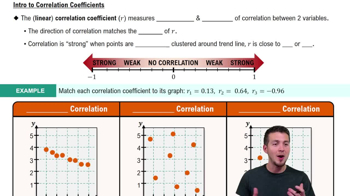A data set is found to have a linear correlation coefficient of . Which of the following graphs most likely represents the relationship between these variables?
Table of contents
- 1. Intro to Stats and Collecting Data1h 14m
- 2. Describing Data with Tables and Graphs1h 55m
- 3. Describing Data Numerically2h 5m
- 4. Probability2h 16m
- 5. Binomial Distribution & Discrete Random Variables3h 6m
- 6. Normal Distribution and Continuous Random Variables2h 11m
- 7. Sampling Distributions & Confidence Intervals: Mean3h 23m
- Sampling Distribution of the Sample Mean and Central Limit Theorem19m
- Distribution of Sample Mean - Excel23m
- Introduction to Confidence Intervals15m
- Confidence Intervals for Population Mean1h 18m
- Determining the Minimum Sample Size Required12m
- Finding Probabilities and T Critical Values - Excel28m
- Confidence Intervals for Population Means - Excel25m
- 8. Sampling Distributions & Confidence Intervals: Proportion1h 12m
- 9. Hypothesis Testing for One Sample3h 29m
- 10. Hypothesis Testing for Two Samples4h 50m
- Two Proportions1h 13m
- Two Proportions Hypothesis Test - Excel28m
- Two Means - Unknown, Unequal Variance1h 3m
- Two Means - Unknown Variances Hypothesis Test - Excel12m
- Two Means - Unknown, Equal Variance15m
- Two Means - Unknown, Equal Variances Hypothesis Test - Excel9m
- Two Means - Known Variance12m
- Two Means - Sigma Known Hypothesis Test - Excel21m
- Two Means - Matched Pairs (Dependent Samples)42m
- Matched Pairs Hypothesis Test - Excel12m
- 11. Correlation1h 6m
- 12. Regression1h 50m
- 13. Chi-Square Tests & Goodness of Fit1h 57m
- 14. ANOVA1h 57m
11. Correlation
Correlation Coefficient
Problem 10.1.17
Textbook Question
Testing for a Linear Correlation
In Exercises 13–28, construct a scatterplot, and find the value of the linear correlation coefficient r. Also find the P-value or the critical values of r from Table A-6. Use a significance level of α = 0.05. Determine whether there is sufficient evidence to support a claim of a linear correlation between the two variables. (Save your work because the same data sets will be used in Section 10-2 exercises.)
Taxis Using the data from Exercise 15, is there sufficient evidence to support the claim that there is a linear correlation between the distance of the ride and the fare (cost of the ride)?
 Verified step by step guidance
Verified step by step guidance1
Step 1: Begin by plotting a scatterplot of the data. Plot the distance of the ride on the x-axis and the fare (cost of the ride) on the y-axis. This will help visualize whether there appears to be a linear relationship between the two variables.
Step 2: Calculate the linear correlation coefficient (r) using the formula: r = (Σ((x - x̄)(y - ȳ))) / √(Σ(x - x̄)² * Σ(y - ȳ)²). Here, x̄ and ȳ are the means of the x and y variables, respectively. This coefficient measures the strength and direction of the linear relationship.
Step 3: Determine the critical values of r or the P-value. Use Table A-6 (or a statistical software) to find the critical values of r for the given sample size and significance level α = 0.05. Alternatively, calculate the P-value associated with the computed r.
Step 4: Compare the absolute value of the calculated r to the critical value (or compare the P-value to α). If |r| > critical value or if P-value < α, there is sufficient evidence to support the claim of a linear correlation.
Step 5: Conclude whether there is sufficient evidence to support the claim of a linear correlation between the distance of the ride and the fare. If the evidence supports the claim, state that a linear correlation exists; otherwise, state that there is no sufficient evidence for a linear correlation.
 Verified video answer for a similar problem:
Verified video answer for a similar problem:This video solution was recommended by our tutors as helpful for the problem above
Video duration:
5mPlay a video:
Was this helpful?
Key Concepts
Here are the essential concepts you must grasp in order to answer the question correctly.
Linear Correlation Coefficient (r)
The linear correlation coefficient, denoted as r, quantifies the strength and direction of a linear relationship between two variables. Its value ranges from -1 to 1, where 1 indicates a perfect positive correlation, -1 indicates a perfect negative correlation, and 0 suggests no linear correlation. Understanding r is crucial for assessing how closely the data points cluster around a straight line in a scatterplot.
Recommended video:
Guided course

Correlation Coefficient
P-value
The P-value is a statistical measure that helps determine the significance of results obtained in hypothesis testing. It represents the probability of observing the data, or something more extreme, assuming the null hypothesis is true. A P-value less than the significance level (α = 0.05 in this case) indicates strong evidence against the null hypothesis, suggesting that a linear correlation may exist between the variables.
Recommended video:
Guided course

Step 3: Get P-Value
Scatterplot
A scatterplot is a graphical representation of two quantitative variables, where each point represents an observation. It helps visualize the relationship between the variables, allowing for the identification of patterns, trends, or correlations. Constructing a scatterplot is a fundamental step in analyzing data, as it provides an intuitive understanding of how the variables interact before calculating statistical measures like the correlation coefficient.
Recommended video:
Guided course

Scatterplots & Intro to Correlation

 5:43m
5:43mWatch next
Master Correlation Coefficient with a bite sized video explanation from Patrick
Start learningRelated Videos
Related Practice
Multiple Choice
